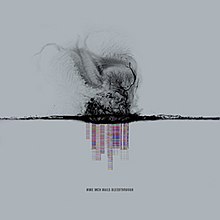With Teeth
In line with the band's previous material, the record features introspective songwriting influenced by Reznor's addiction to alcohol and drugs and subsequent sobriety.
Nine Inch Nails garnered mainstream attention with their influential second album The Downward Spiral, as well as a widely broadcast live performance at Woodstock '94, becoming one of the most popular music acts of the 1990s.
The 1999 Nine Inch Nails double album The Fragile was met with generally positive reviews from music critics and eventually sold 898,000 copies.
"[4] After Reznor decided to go to rehab, he began work on a new album and found that the songwriting process moved along easier for him than in the past.
[8][9] According to a statement on the official Nine Inch Nails website, Reznor stated that producer Rick Rubin was his "mentor" and "source of inspiration" throughout the planning and writing process of the album.
[10] Reznor was heavily inspired by the use of more analog electronic effects and instruments, specifically tape delay and modular synthesizers.
[6] A post on the band's official website dated May 5 indicated that Reznor, Ross, and Leo Herrera were in the studio recording and "refining" rough new material.
[19] The album's sound also draws inspirations from genres such as drum and bass, pop, electronica, ambient,[20] trip hop,[21][22] and acid house.
[25] In a book about the earlier Nine Inch Nails album Pretty Hate Machine, author Daphne Carr noted that "All the Love in the World" was one of Nine Inch Nails' deeper songs noting the lyrics "Watching all the insects march along, seem to know just right where they belong, smears of face reflecting in the chrome, hiding in the crowd I'm all alone.
With Teeth is the last Nine Inch Nails studio album to include the Nothing Records logo in the packaging, since it was declared extinct after the February 2007 inclusion of the Beside You in Time home video.
Those who pre-ordered the album received a limited edition 7" vinyl containing the single "The Hand That Feeds," as well as the B-side track "Home."
[33] In addition to 5.1 surround and stereo mixes of the songs, the DualDisc (and DVD) contain the video for "The Hand That Feeds", an interactive discography and a slide show of album artwork.
[40] The band followed up with a North American arena tour in autumn 2005, supported by Queens of the Stone Age, Autolux, Death from Above 1979, and hip hop artist Saul Williams.
[41] The second leg of the tour consisted of a series of North American amphitheaters performances in the summer of 2006, supported by Bauhaus, TV on the Radio, and Peaches.
[44] Rolling Stone's Rob Sheffield described the album as "vintage Nine Inch Nails",[51] while Stylus Magazine said "The words 'triumphant return' are apt.
"[54] Rock critic Robert Christgau gave it a lukewarm review, commenting in The Village Voice, "All pretense of deeper meaning worn into shtick, [Reznor] is left with the aggro mood music that was always his calling.
"[55] Newsday gave With Teeth a rating of A− and called it "a strong reminder why, despite his lengthy absences, Reznor remains alt-rock royalty.
"[57] PopMatters critically slammed the album, summarizing its poor review by simply saying "Trent Reznor has run out of ideas.
"[58] In the review for AllMusic, editor Stephen Thomas Erlewine was also muted in his praise for the album, claiming that "[It] is the work of a craftsman, a musician who meticulously assembles his work by layering details so densely, there's never a moment on the record where something isn't roiling under the surface, where something isn't added to the mix.


